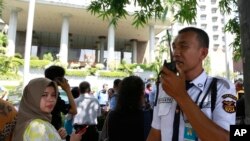A series of earthquakes and volcanic eruptions jolted locations on opposite ends of the Pacific Ocean Tuesday.
The U.S. Geological Survey says a massive 8.2 magnitude earthquake struck about 280 kilometers southeast of Alaska's Kodiak Island, initially prompting emergency officials to issue a tsunami warning for large parts of coastal Alaska and Canada's British Columbia and place the entire U.S. west coast and the U.S. Pacific state of Hawaii under a tsunami watch. Residents in the immediate were urged to evacuate to higher ground or move inland.
The tsunami warning was later canceled.
Japan volcanic eruption
Several hours earlier and more than 5,000 kilometers away, a Japanese soldier was killed and several other people injured as a result of a volcanic eruption near a mountain ski resort.
Dozens of skiers were struck by flying rocks caused by the midday eruption of Mount Kusatsu-Shirane, including a group of six members of Japan's Self Defense Force who were taking part in a training mission. The eruption triggered an avalanche that buried them under mounds of snow for a few hours until they were rescued.
The volcano knocked out power at the resort, which left at least 80 other skiers stranded at a gondola station at the top of the mountain for several hours before they were rescued by helicopter. A few skiers were reportedly injured when flying rocks shattered the glass of their gondola.
Philippines volcano
In the Philippines, authorities have raised the alert level after several days of increasingly intense activity at its most active volcano. The 2,642-meter tall Mount Mayon, located more than 300 kilometers from Manila, gushed lava fountains as much as 700 meters in the air above its crater Tuesday, followed by ash clouds reaching three (3) kilometers in the air Tuesday. The volcano first began belching red-hot lava, ash and superheated gas and volcanic debris nearly two weeks ago.
The Philippine Institute of Volcanology has raised its alert level for Mayon to four on a scale of five, signifying hazardous eruption is imminent. The agency also expanded the danger zone surrounding the volcano to eight kilometers. As many as 40,000 residents have been forced to evacuate to safer ground as Mayon becomes more and more unstable.
Indonesia quake
And office workers in the Indonesian capital of Jakarta ran out into the streets in panic Tuesday when a magnitude 6.0 earthquake shook high-rise office buildings. The U.S. Geological Survey said the quake was centered off about 43 kilometers off the coast of the western island of Java, but Indonesian emergency officials did not issue a tsunami warning.
Japan, the Philippines and Indonesia are all located along the so-called "Ring of Fire," a line of seismic faults in the Pacific Ocean that is prone to earthquakes and volcanic activity.
Mike West, a seismologist with the Alaska Earthquake Center, told VOA the earthquake that struck the U.S. Pacific state Tuesday was not connected to the seismic activities in the three Asia Pacific locations.











